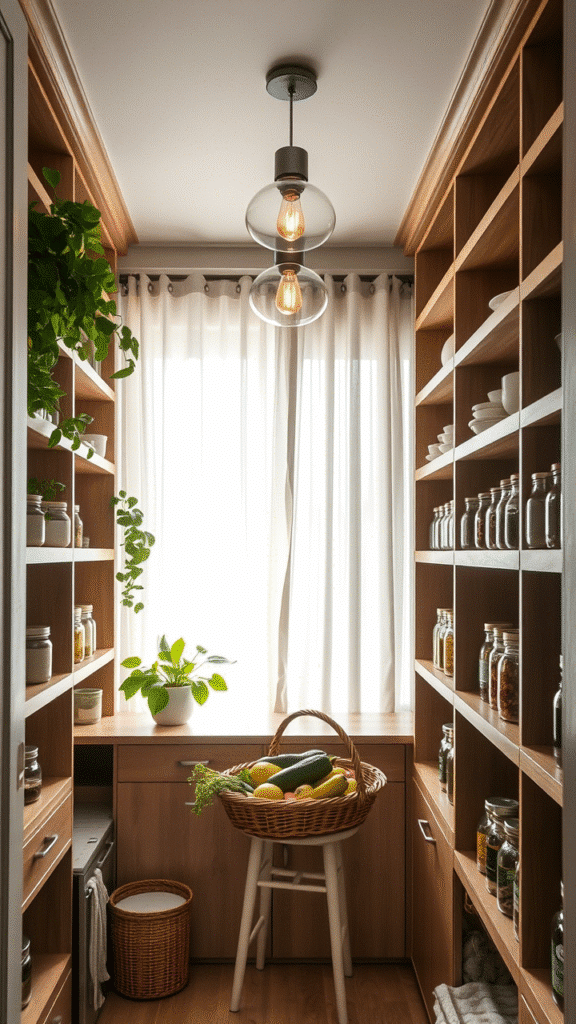If you blink, you’ll miss it.
That’s how fast a tiny pantry can go from “fresh and fancy” to “what even is this chaos?”.
We all been there. Small homes, smaller kitchens… and don’t even talk about storage. But a tiny walk-in pantry? Oh yes. It can be the game-changer you didn’t know you were craving.
This ain’t just about storing canned beans or hiding cereal boxes anymore.
It’s about turning that forgotten broom closet or that awkward nook beside the fridge into a full-on snack sanctuary with a layout that actually works.
And shelves and countertops? They’re the backbone. Without ’em, it’s just a dusty closet pretending to be useful.
Embracing the Walk-In (Even If It’s Only 3 Steps Deep)
Let’s just be real—“walk-in” in a tiny home don’t mean ballroom-sized.
It might be two feet wide and three feet long, but if you can stand in it and turn without knocking off a box of pasta, you’re golden.
Start by sketchin’ it out. No, not in your head. Use a pencil. Paper. A napkin, even.
Measure the depth. The height. The weird angle where the wall slopes for no reason at all.
Now take a step back and stare at the space like it owes you money.
That’s your blank canvas.
Shelves: Stack ‘Em Tall, Stack ‘Em Tight
In a compact pantry, shelves gotta work overtime.
You’re not just stacking food. You’re stacking function.
Start from the top. The very top. Like, neck-craning top.
Install a deep shelf for long-term stuff you don’t use daily.
Holiday tins. Cookie cutters you use once a year. Grandma’s five-pound mixer.
Come down a bit—shoulder height to belly button zone. That’s your everyday range.
Cereal, rice, peanut butter, the emergency chocolate.
Use adjustable shelves here. Your needs change, and so should your shelves.
Go even lower. Almost floor level.
Bulky stuff lives here. Think potatoes, onions, big jugs of oil, extra paper towels.
You can chuck ’em in cute bins if you’re feelin’ fancy. But they better be sturdy.
Oh, and please don’t forget shelf risers.
They basically double your space without takin’ up any. It’s like magic, but from the dollar store.
Countertops in a Closet? Yup, It Works.

Now listen here.
A tiny pantry with a countertop is like havin’ a butler in a shoebox. Unexpected, but glorious.
Just a slim slab—could be butcher block, laminate, heck even sealed plywood if you’re broke and brave.
Run it across one wall or corner. Don’t make it deep. A solid 14 inches is enough.
This little counter becomes your workhorse.
You can load groceries here before puttin’ them away.
You can set a toaster, a coffee maker, even a lil bread machine.
Ever prep sandwiches in your pantry? Try it once. You’ll never go back.
Underneath the counter? That’s hidden gold.
Slide in wire baskets, recycling bins, pet food containers. Maybe even a lil mini-fridge if the power outlet gods allow.
Layout: Zig-Zag or L-Shape?
Most tiny walk-in pantries got two real layout options: L-shaped or straight shot.
Don’t fight it. Work with what you got.
If it’s narrow but long? Do one wall. All shelves on one side. Maybe shallow shelves on the opposite just so it don’t feel claustrophobic.
Got a square-ish space? L-shape’s your friend.
Do shelves on one wall, counter on the other.
Let ’em meet at the corner like two besties reuniting at brunch.
Don’t forget vertical corners. Use em.
Corner shelves, Lazy Susans, or even a tall basket tower.
Dead corners are a crime in small homes.
Clear Containers: Not Just for Instagram
Yeah, yeah, we’ve all seen the perfectly labeled jars with rainbow lentils.
But clear containers ain’t just for aesthetics—they’re strategy.
When you can see what’s inside, you waste less.
And ain’t nothin’ sadder than discovering six half-empty rice bags hiding behind expired crackers.
Use stackable bins for snacks. Airtight jars for dry goods.
Label ’em if you’re organized. Or don’t. Just don’t put flour in the sugar jar. Again.
Hooks, Rods, and Hangers—The Wall Ain’t Just a Wall

Don’t stop at shelves. Your wall’s got moves. Use it.
Stick some command hooks for oven mitts or aprons.
Install a rod with S-hooks to hang scissors, garlic braids, or tiny baskets.
Heck, hang your reusable grocery bags there. They deserve a home too.
One wall panel with a pegboard? Pure brilliance.
You can shift stuff around as needed, like a pantry Tetris champion.
Light It Up—Don’t Cook in the Shadows
Tiny pantries get dark. Fast.
One overhead bulb ain’t enough.
Install LED strips under the shelves.
Get motion sensor lights if you’re lazy (no shame).
Even a battery lamp with double-sided tape can save you from grabbin’ cumin instead of cinnamon.
You ever dumped cumin in oatmeal? No? Exactly. Add lights.
Keep the Door… Or Don’t
Doors can be a blessing or a blockade.
If your pantry door swings out and blocks the hallway, ditch it.
Use a curtain, a barn door, or go open-concept if you don’t mind showin’ off your canned soup stash.
Prefer privacy? Go for a glass or frosted door.
Looks cute. Hides mess. Best of both worlds.
Even better—use the back of the door. Install racks.
Spices, snacks, foil rolls, weird sauces you bought on impulse. All belong there.
A Spot for Small Appliances

Tiny walk-in pantries don’t just store food.
They rescue your countertop from appliance traffic.
Make room for the slow cooker, air fryer, rice cooker… all the gadgets.
Slide-out shelves or pull-out trays? Heaven-sent.
Plug ’em in right there, if you can.
That way, your pantry becomes a backup kitchen when the main one’s on strike.
Organize Like Your Sanity Depends on It
Because… well, it kinda does.
Sort by type. Pasta with pasta. Snacks with snacks.
Group canned stuff by use—soups, beans, veggies.
Create zones. Breakfast zone. Baking zone. Grab-n-go zone. Emergency ice cream zone.
Reassess monthly. Don’t let mystery bags pile up.
If something smells funky or looks like a science project—toss it. Don’t wait for it to sprout legs.
The Floor Ain’t Just There to Catch Crumbs
Don’t sleep on floor storage.
A rolling cart down low can hold cleaning supplies or backups.
Or slide in low bins with wheels.
Label ’em: “BACKSTOCK”, “PET FOOD”, “HIDE FROM KIDS”.
Just… don’t overload the floor. You still gotta walk in, right?
Design Touches That Actually Matter

Yes, it’s just a pantry.
But it can still look good.
Paint the walls something bright. Pale yellow. Mint. Even crisp white.
It makes the space feel less like a closet and more like a cozy nook.
Wallpaper one wall if you’re bold. Something fun. Pineapples? Go for it.
Install a mini chalkboard or a grocery list notepad.
Add a small rug—just one you can shake out easy.
Suddenly, your pantry becomes a place, not just a space.
Budget Ideas If Your Wallet’s Cryin’
You don’t gotta drop big bucks.
Use crates from the produce market for shelves.
Repurpose old furniture—like a nightstand as pantry drawers.
Thrift stores and dollar shops? Absolute goldmines.
Heck, some of the best pantries started with “what do I already have?”
Repurpose jars, bins, shoeboxes (yes, really). Just wrap ’em in cute paper or paint ’em.
Add shelf liner. Instant glow-up.
Make It Yours
Here’s the real trick to a successful tiny pantry:
Make it yours. Not Pinterest’s. Not your neighbor’s.
Love baking? Prioritize your flour, sugar, mixers, sprinkles.
Hate cooking but love snacks? Make it a snack bar with a cold brew station.
Got pets? Dedicate a corner to their treats and supplies.
There ain’t no rulebook for small-space pantries.
Only rule is—does it work for you?
If it does, then congrats. You just turned a closet into the most useful room in your home.
Final Thought
A tiny walk-in pantry ain’t about size. It’s about sense.
Make it work smart. Make it feel like a hidden gem.
And when someone walks in and goes, “Whoa, this is in here?”—you’ll know you nailed it.
Tiny homes deserve clever dreams. Start with the pantry.
FAQs
1. Can I build a walk-in pantry in a rental home?
Yep! Use freestanding shelves and no-drill wall solutions. Keep it all reversible.
2. What’s the best shelf depth for small pantries?
Around 12 to 16 inches. Deep enough to hold jars, not so deep you lose stuff in the back.
3. How do I keep my pantry from feeling cluttered?
Group items in bins, use labels, and clean it out monthly. Less is more in tiny spaces.
4. Can I use a corner of my laundry room as a pantry?
Totally. Just keep food separate from cleaning supplies. Add bins or curtains if needed.
5. Is ventilation important in a pantry?
Yes, especially in humid spots. A small vent or fan helps prevent mold and keeps things fresh.
